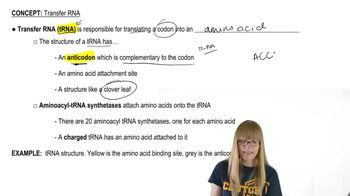Table of contents
- 1. Introduction to Genetics51m
- 2. Mendel's Laws of Inheritance3h 37m
- 3. Extensions to Mendelian Inheritance2h 41m
- 4. Genetic Mapping and Linkage2h 28m
- 5. Genetics of Bacteria and Viruses1h 21m
- 6. Chromosomal Variation1h 48m
- 7. DNA and Chromosome Structure56m
- 8. DNA Replication1h 10m
- 9. Mitosis and Meiosis1h 34m
- 10. Transcription1h 0m
- 11. Translation58m
- 12. Gene Regulation in Prokaryotes1h 19m
- 13. Gene Regulation in Eukaryotes44m
- 14. Genetic Control of Development44m
- 15. Genomes and Genomics1h 50m
- 16. Transposable Elements47m
- 17. Mutation, Repair, and Recombination1h 6m
- 18. Molecular Genetic Tools19m
- 19. Cancer Genetics29m
- 20. Quantitative Genetics1h 26m
- 21. Population Genetics50m
- 22. Evolutionary Genetics29m
11. Translation
Translation
Problem 3b
Textbook Question
Contrast the roles of tRNA and mRNA during translation, and list all enzymes that participate in the transcription and translation process.
 Verified step by step guidance
Verified step by step guidance1
Understand the roles of tRNA and mRNA: mRNA (messenger RNA) carries the genetic information from DNA to the ribosome, where proteins are synthesized. tRNA (transfer RNA) brings the appropriate amino acids to the ribosome during protein synthesis.
Explore the function of mRNA: mRNA is synthesized during transcription and serves as a template for the sequence of amino acids in a protein. It contains codons, which are sequences of three nucleotides that correspond to specific amino acids.
Explore the function of tRNA: tRNA molecules have an anticodon region that is complementary to the mRNA codons. Each tRNA is linked to a specific amino acid, which it delivers to the growing polypeptide chain during translation.
List enzymes involved in transcription: The main enzyme is RNA polymerase, which synthesizes mRNA from the DNA template. Other factors include transcription factors and helicase, which unwinds the DNA.
List enzymes involved in translation: While translation does not involve enzymes in the same way as transcription, it requires ribosomal RNA (rRNA) and ribosomal proteins to form the ribosome, as well as aminoacyl-tRNA synthetase, which charges tRNA with the correct amino acid.
 Verified video answer for a similar problem:
Verified video answer for a similar problem:This video solution was recommended by our tutors as helpful for the problem above
Video duration:
1mPlay a video:
Was this helpful?
Key Concepts
Here are the essential concepts you must grasp in order to answer the question correctly.
tRNA (Transfer RNA)
tRNA is a type of RNA molecule that plays a crucial role in translation by transporting specific amino acids to the ribosome, where proteins are synthesized. Each tRNA molecule has an anticodon that pairs with a corresponding codon on the mRNA strand, ensuring that the correct amino acid is added to the growing polypeptide chain. This process is essential for translating the genetic code into functional proteins.
Recommended video:
mRNA (Messenger RNA)
mRNA is a single-stranded RNA molecule that carries genetic information from DNA to the ribosome, where it serves as a template for protein synthesis during translation. It is transcribed from the DNA and contains codons, which are sequences of three nucleotides that specify which amino acids will be added to the protein. The sequence of codons in mRNA ultimately determines the structure and function of the resulting protein.
Recommended video:
Enzymes in Transcription and Translation
Several key enzymes are involved in transcription and translation. During transcription, RNA polymerase synthesizes mRNA from a DNA template. In translation, aminoacyl-tRNA synthetases attach amino acids to their corresponding tRNA molecules, while peptidyl transferase, part of the ribosome, catalyzes the formation of peptide bonds between amino acids. These enzymes are vital for ensuring accurate and efficient protein synthesis.
Recommended video:
Guided course

Translation initiation

 7:58m
7:58mWatch next
Master Translation initiation with a bite sized video explanation from Kylia Goodner
Start learning





